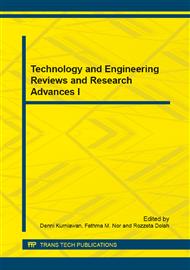[1]
Ezra, A.A., Principles and practice of explosive metalworking1973: Industrial Newspapers.
Google Scholar
[2]
Otto, H., Dowling, A., and Sullivan, R., A comparison of the effects of explosive forming and static deformation on the mechanical properties of pressure vessel steels. Metallurgical Transactions, 1973. 4(3): pp.657-661.
DOI: 10.1007/bf02643071
Google Scholar
[3]
Hadavi, V., Zamani, J., and Hosseini, R., The empirical survey on the effect of using media in explosive forming of tubular shells. World Academy of Science, Engineering and Technology, 2009. 60: pp.574-579.
Google Scholar
[4]
Alipour, R., Finite element analysis of elongation in free explosive forming of aluminum alloy blanks using CEL method. International Review of Mechanical Engineering, 2011. 5(6): pp.1039-1042.
Google Scholar
[5]
Kowsarinia, E., Alizadeh, Y., and Pour, H.S., Theoretical and experimental study on the effects of explosive forming parameters on plastic wrinkling of annular plates. The International Journal of Advanced Manufacturing Technology, 2012: pp.1-9.
DOI: 10.1007/s00170-012-4532-2
Google Scholar
[6]
Kawka, M., Olejnik, L., Rosochowski, A., Sunaga, H., and Makinouchi, A., Simulation of wrinkling in sheet metal forming. Journal of Materials Processing Technology, 2001. 109(3): pp.283-289.
DOI: 10.1016/s0924-0136(00)00813-x
Google Scholar
[7]
Metal Forming Handbook1998: Springer Berlin Heidelberg.
Google Scholar
[8]
Sekiguchi, A. and Arai, H., Control of wall thickness distribution by oblique shear spinning methods. Journal of Materials Processing Technology, 2012. 212(4): pp.786-793.
DOI: 10.1016/j.jmatprotec.2011.11.002
Google Scholar
[9]
Wong, C.C., Dean, T.A., and Lin, J., A review of spinning, shear forming and flow forming processes. International Journal of Machine Tools and Manufacture, 2003. 43(14): pp.1419-1435.
DOI: 10.1016/s0890-6955(03)00172-x
Google Scholar
[10]
Liuru, Z. Study of cone NC sheet metal incremental forming. in Mechanic Automation and Control Engineering (MACE), 2011 Second International Conference on. (2011).
DOI: 10.1109/mace.2011.5988835
Google Scholar
[11]
Firat, M., Computer aided analysis and design of sheet metal forming processes: Part III: Stamping die-face design. Materials & Design, 2007. 28(4): pp.1311-1320.
DOI: 10.1016/j.matdes.2006.01.025
Google Scholar
[12]
Semiatin, S.L. and Committee, A.I.H., ASM Handbook2006: ASM International.
Google Scholar
[13]
Atlas of Stress-Strain Curves, 2nd Edition2002: ASM International.
Google Scholar
[14]
Suchy, I., Handbook of Die Design2005: McGraw-Hill.
Google Scholar
[15]
Rajendran, R. and Lee, J.M., Blast loaded plates. Marine Structures, 2009. 22(2): pp.99-127.
DOI: 10.1016/j.marstruc.2008.04.001
Google Scholar
[16]
Zhang, S., Wang, G., Wang, C., Pang, B., and Du, C., Numerical simulation of failure modes of concrete gravity dams subjected to underwater explosion. Engineering Failure Analysis, 2014. 36(0): pp.49-64.
DOI: 10.1016/j.engfailanal.2013.10.001
Google Scholar
[17]
Rajendran, R., Effective shock factors for the inelastic damage prediction of clamped plane plates subjected to non-contact underwater explosion. The Journal of Strain Analysis for Engineering Design, 2009. 44(3): pp.211-220.
DOI: 10.1243/03093247jsa463
Google Scholar
[18]
Alipour, R., Izman, S., and Tamin, M.N., Estimation of Charge Mass for High Speed Forming of Circular Plates Using Energy Method. Advanced Materials Research, 2014. 845: pp.803-808.
DOI: 10.4028/www.scientific.net/amr.845.803
Google Scholar
[19]
Spranghers, K., Vasilakos, I., Lecompte, D., Sol, H., and Vantomme, J., Numerical simulation and experimental validation of the dynamic response of aluminum plates under free air explosions. International Journal of Impact Engineering, 2013. 54(0): pp.83-95.
DOI: 10.1016/j.ijimpeng.2012.10.014
Google Scholar
[20]
Abaqus 6. 12 Analysis User's Manual. Vol. 4. 2012: Dassault Systèmes.
Google Scholar


